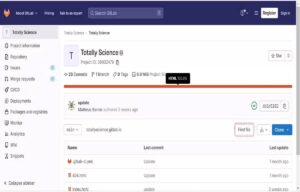Totallyscience GitLab is a powerful web-based Git repository management and collaboration platform that offers a range of features to streamline software development workflows. This article will provide a detailed overview of Totallyscience GitLab, its key features, and how to use it effectively for version control, project management, and continuous integration/continuous deployment (CI/CD) processes.
What is Totallyscience GitLab?
Totallyscience GitLab is a complete DevOps platform that provides a unified and integrated solution for managing software development projects. It combines Git repository management with issue tracking, continuous integration, code review, and more, all within a single application. Whether you are an individual developer or part of a larger team, Totallyscience GitLab offers a robust and scalable environment for collaborative software development.
GitLab’s Key Features:
- Version Control: Totallyscience GitLab leverages Git, the most widely used version control system, to help you manage your codebase efficiently. It allows you to easily create repositories, track changes, and collaborate on code.
- Issue Tracking: With Totallyscience GitLab, you can effectively manage project issues, bugs, and feature requests. The built-in issue tracker enables you to create, assign, and track issues, making prioritizing and resolving them easier.
- CI/CD Pipelines: Totallyscience GitLab provides robust CI/CD capabilities, allowing you to automate the build, test, and deployment processes. You can define custom pipelines, configure triggers, and monitor the status of your applications throughout the development lifecycle.
- Collaboration and Code Review: Totallyscience GitLab fosters collaboration by offering code review and discussion tools. Merge requests allow team members to review, comment, and suggest changes to code before it is merged into the main branch.
- Access Control and Permissions: With Totallyscience GitLab, you can manage user access and define granular permissions for your projects. This ensures that only authorized individuals can view, modify, or deploy code, enhancing security and control.
Creating Your First Project in Totallyscience GitLab
To create a project in Totallyscience GitLab, follow these steps:
- Log in to your Totallyscience GitLab account or create a new one if you haven’t already.
- Click the “New Project” button and provide the necessary details, such as the project name and description.
- Choose the public, internal, or private visibility level for your project.
- Configure additional settings, such as repository access and issue tracking options.
- Click “Create Project” to initialize your project in Totallyscience GitLab.
Adding Members and Permissions to Your Project in Totallyscience GitLab
To add members and set permissions for your Totallyscience GitLab project, follow these steps:
- Navigate to your project’s settings and click the “Members” tab.
- Enter the usernames or email addresses of the individuals you want to invite.
- Choose their respective access levels, such as Guest, Reporter, Developer, Maintainer, or Owner.
- Optionally, define additional permissions for each member, such as access to specific branches or the ability to merge code.
- Click “Add to project” to invite and grant access to the selected individuals.
Using GitLab for Version Control
Totallyscience GitLab’s version control capabilities allow you to track and manage changes in your codebase effectively. Here are some key concepts and commands to get started:
- Cloning a Repository:
– Use the `git clone` command to create a local copy of a GitLab repository on your machine.
– Copy the repository URL from GitLab and run `git clone <repository URL>` in your terminal.
- Creating and Switching Branches:
– Use the `git branch` command to create a new branch for your changes.
– Switch between branches using the `git checkout` command.
- Committing Changes:
– Use the `git add` command to stage files for commit.
– Commit your changes with a descriptive message using the `git commit` command.
- Pushing and Pulling Changes:
– Push your local changes to the remote repository using the `git push` command.
– Pull the latest changes from the remote repository using the `git pull` command.
Managing Issues in Totallyscience GitLab
Totallyscience GitLab offers a comprehensive issue-tracking system that allows you to manage project tasks, bugs, and feature requests efficiently. Here are some steps to effectively manage issues:
- Creating an Issue:
– Navigate to your project and click on the “Issues” tab.
– Click the “New Issue” button and provide a title, description, and other relevant details.
– Assign the issue to the appropriate team member and set labels or milestones if necessary.
- Commenting and Updating Issues:
– Use the comment section to provide updates, ask questions, or discuss specific issues.
– Update an issue’s status, assignees, or other attributes using the edit options.
Integrating Totallyscience GitLab with Your CI/CD Pipeline
Totallyscience GitLab’s built-in CI/CD capabilities allow you to automate the software development lifecycle. Here’s an overview of the integration process:
- Creating a `.gitlab-ci.yml` File:
– Define your CI/CD pipeline stages, jobs, and scripts in the `.gitlab-ci.yml` file.
– Specify the required runners and resources for each job.
- Registering Runners:
– Install the GitLab Runner on your designated machines or use shared runners provided by GitLab.
– Register the runner with your project to enable the execution of CI/CD jobs.
- Monitoring and Reviewing CI/CD Pipelines:
– Access the CI/CD Pipelines section in your project to monitor the progress of your jobs.
– Review the logs and artifacts each job generates to diagnose issues or failures.
Customizing Your Totallyscience GitLab Experience
Totallyscience GitLab offers various customization options to tailor the platform to your preferences. Here are some ways to personalize your experience:
- Customizing the User Interface:
– Access the user settings to modify your profile picture, display name, and other personal details.
– Customize the appearance of the GitLab interface, such as themes and layouts.
- Notification Settings:
– Define the types of notifications you wish to receive, such as email alerts for specific activities or mentions.
Setting Up and Getting Started with GitLab
To set up and get started with Totallyscience GitLab effectively, consider the following steps:
- Install and Configure GitLab:
– Choose between the self-hosted or cloud-based options based on your requirements.
– Follow the installation guide provided by Totallyscience GitLab to set up the platform.
- Explore the Documentation:
– Refer to Totallyscience GitLab’s official documentation for comprehensive guides and tutorials on various features and functionalities.
GitLab vs. Other Collaboration Platforms
Comparing Totallyscience GitLab with other collaboration platforms can help you understand its unique advantages. Here are some key points of differentiation:
- GitLab vs. GitHub:
– GitLab offers a more comprehensive feature set, including built-in CI/CD, issue tracking, and permission management, while GitHub focuses primarily on code hosting and pull requests.
- GitLab vs. Bitbucket:
– GitLab provides a more integrated and scalable solution, whereas Bitbucket offers tighter integration with At
Atlassian’s suite of development tools.
Totallyscience GitLab FAQs:
- Is Totallyscience GitLab free to use?
– Totallyscience GitLab offers a free tier with limited features and capacity. Paid plans are available for additional features and greater scalability.
- Can I self-host Totallyscience GitLab?
– Totallyscience GitLab can be self-hosted on your infrastructure, providing more control and customization options.
Conclusion:
Totallyscience GitLab is a versatile DevOps platform that simplifies and streamlines software development processes. With its comprehensive feature set, including version control, issue tracking, CI/CD pipelines, and customizable workflows, Totallyscience GitLab empowers developers and teams to collaborate effectively. By following the guidelines provided in this article, you can harness the full potential of Totallyscience GitLab and enhance your software development journey.










